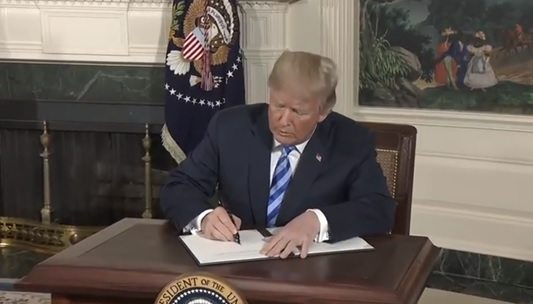 Photo Courtesy of: The White House
Photo Courtesy of: The White House
Making Sanctions Against Russia Work
The Trump administration announced new sanctions in March and April against Russia in response to interference in the 2016 election, among other hostilities. The first set were suspected to be imposed only to comply with the Countering America’s Adversaries Through Sanctions Act and offer a response to the poisoning of a former Russian spy. The harsher penalties imposed later, have taken a toll on the ruble and the economy. Despite this immediate impact, the sanctions are unlikely to have a long-term effect on the economy or achieve the U.S.’ goals. Sanctions have become the U.S.’ primary response to aggression, but considering Russia’s resilient economy, it is unclear how well they really work in this context.
Russia’s economy had been in decline since 2012, two years before oil prices dropped and the Obama administration imposed sanctions after Russia annexed Crimea. Russia’s GDP fell by 2.089% in 2015 after the imposition of the sanctions. Due to Russia’s dependence on oil and the subsequent economic growth in 2016, the downward trend demonstrates that the sharp drop in oil prices had a greater impact on Russia’s falling economy than the sanctions.
History has shown that economic sanctions have rarely worked when trying to change the overall behavior of a state or deter broad actions. This was seen when the U.S. imposed an embargo on Cuba in an attempt to economically isolate the state and in order to encourage political change—namely the Castro family stepping down from power, installing democratic political processes, and upholding personal freedoms. The strict sanctions against Cuba failed to cause significant change over six decades because the goal was not achievable through a unilateral economic penalty.
One of the largest issues with the U.S.’ sanctions on Russia, both past and present, is the lack of a specific and achievable goal. Sanctions imposed against Russia are supposed to force a change in Russia’s behavior and deter future aggression, but so far, this has not been achieved. Despite sanctions, Russia is still occupying parts of Ukraine, and there is still fear about the risks Russia poses to future U.S. elections.
There are, however, instances when sanctions worked as intended. For instance, Iran and the Joint Comprehensive Plan of Action (JCPOA) is a clear example of when the U.S. had a specific goal that could be achieved through a multilateral economic penalty. The U.S., the other P5+1 countries, and the EU imposed sanctions on Iran, effectively cutting it off from the global economy. The JCPOA offered an incentive for Iran to adhere to the strict limitations on its nuclear program by lifting the sanctions. If Iran had violated the agreement, the multilateral sanctions would have been reinstated, again isolating Iran’s economy. Though the U.S. has officially withdrawn, reports from the International Atomic Energy Agency have consistently shown that Iran has stayed within the restrictions of the agreement, underscoring the success of the threat of multilateral sanctions.
Increasingly globalized markets make it harder to achieve goals in Russia with unilateral sanctions. Multi-national companies are bolstering parts of Russia’s economy to manage the impact of sanctions and prices of commodities. This undermines the overall impact of the sanctions, and further prevents any chance the sanctions had at providing the desired effect. Sanctions can be an effective policy in certain situations, but they must have a clearly defined and specific goal that is achievable through economic pressure. If this is not the case when implementing sanctions—against Russia or any other entity—they will be unsuccessful. The U.S. needs to enlist a wider range of partners and establish more definite and measurable goals with Russia for sanctions to be the most effective tool.






